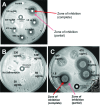In Vitro Characterization of Variable Porosity Wound Dressing With Anti-Scar Properties
- PMID: 29896321
- PMCID: PMC5981800
In Vitro Characterization of Variable Porosity Wound Dressing With Anti-Scar Properties
Abstract
Introduction: New options are needed to improve wound healing while preventing excessive scar formation. Temporary primary dressings are important options in topical wound management that allow the natural healing process. Methods: We evaluated a novel primary dressing consisting of a biosynthetic, variable porosity, matrix-containing gelatin and Aloe Vera extract and a derivative dressing coated with the anti-scarring agent salinomycin for their ability to promote cell growth, reduce myofibroblast formation, and regulate cytokine production. In addition, salinomycin-coated primary dressings were tested for antimicrobial activity. Results: Both primary wound dressings permitted cell growth and attenuated TGFβ-induced scar-forming myofibroblast formation. The primary wound dressings also reduced IL-6 production by 50%, IL-8 by 20%, MCP-1 by 75%, and GRO by 60% in human mesenchymal stem cells treated with TGFβ. Salinomycin coating of the dressing showed antimicrobial activity by preventing Staphylococcus aureus growth. Conclusions: Both primary wound dressings support the growth of human fibroblasts and stem cells, as well as reduce inflammatory cytokine production, demonstrating their potential to serve as temporary wound dressings.
Keywords: antimicrobial; excessive scarring; mesenchymal stem cell; myofibroblast; salinomycin.
Figures





References
-
- Huang JS, Wang YH, Ling TY, Chuang SS, Johnson FE, Huang SS. Synthetic TGF-beta antagonist accelerates wound healing and reduces scarring. FASEB J. 2002;16:1269–70. - PubMed
-
- Dimmeler S, Zeiher AM. Netting insights into fibrosis. N Engl J Med. 2017;376:1475–7. - PubMed
-
- Tan H, Wasiak J, Paul E, Cleland H. Effective use of Biobrane as a temporary wound dressing prior to definitive split-skin graft in the treatment of severe burn: a retrospective analysis. Burns. 2015;41:969–76. - PubMed
LinkOut - more resources
Full Text Sources
Other Literature Sources
Miscellaneous
